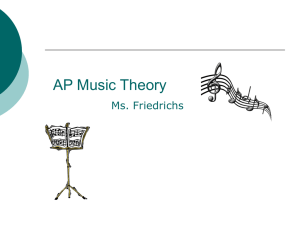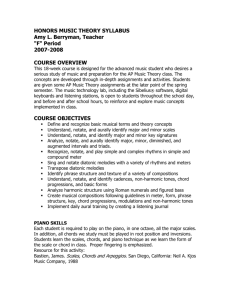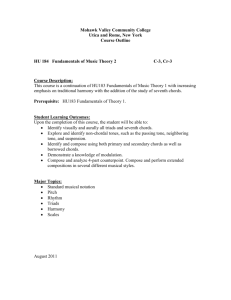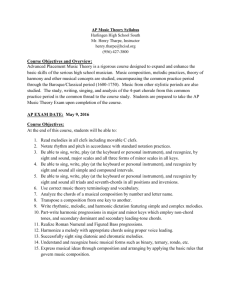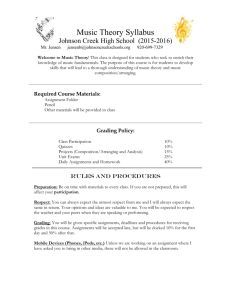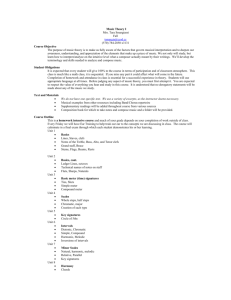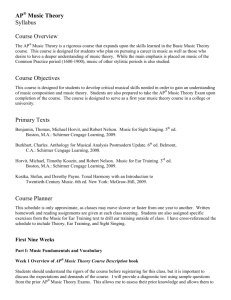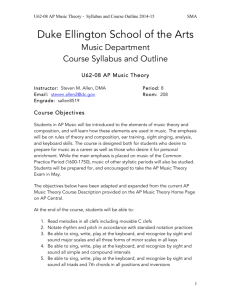AP Theory Syllabus - Ankeny Community School District
advertisement
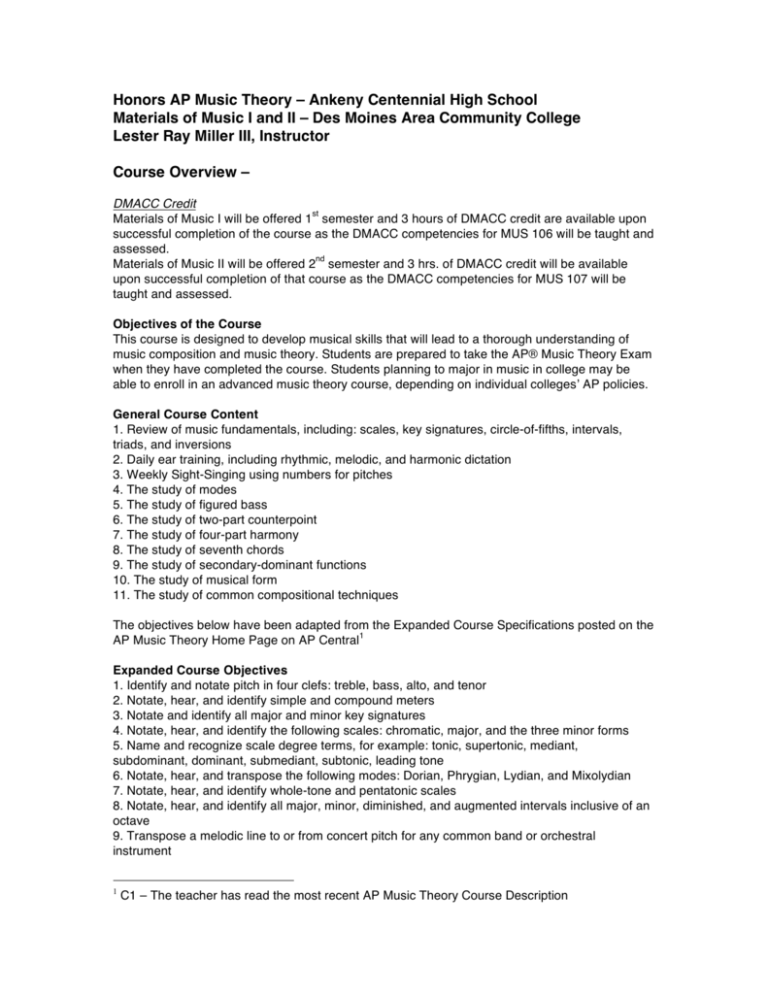
Honors AP Music Theory – Ankeny Centennial High School Materials of Music I and II – Des Moines Area Community College Lester Ray Miller III, Instructor Course Overview – DMACC Credit st Materials of Music I will be offered 1 semester and 3 hours of DMACC credit are available upon successful completion of the course as the DMACC competencies for MUS 106 will be taught and assessed. nd Materials of Music II will be offered 2 semester and 3 hrs. of DMACC credit will be available upon successful completion of that course as the DMACC competencies for MUS 107 will be taught and assessed. Objectives of the Course This course is designed to develop musical skills that will lead to a thorough understanding of music composition and music theory. Students are prepared to take the AP® Music Theory Exam when they have completed the course. Students planning to major in music in college may be able to enroll in an advanced music theory course, depending on individual colleges’ AP policies. General Course Content 1. Review of music fundamentals, including: scales, key signatures, circle-of-fifths, intervals, triads, and inversions 2. Daily ear training, including rhythmic, melodic, and harmonic dictation 3. Weekly Sight-Singing using numbers for pitches 4. The study of modes 5. The study of figured bass 6. The study of two-part counterpoint 7. The study of four-part harmony 8. The study of seventh chords 9. The study of secondary-dominant functions 10. The study of musical form 11. The study of common compositional techniques The objectives below have been adapted from the Expanded Course Specifications posted on the 1 AP Music Theory Home Page on AP Central Expanded Course Objectives 1. Identify and notate pitch in four clefs: treble, bass, alto, and tenor 2. Notate, hear, and identify simple and compound meters 3. Notate and identify all major and minor key signatures 4. Notate, hear, and identify the following scales: chromatic, major, and the three minor forms 5. Name and recognize scale degree terms, for example: tonic, supertonic, mediant, subdominant, dominant, submediant, subtonic, leading tone 6. Notate, hear, and transpose the following modes: Dorian, Phrygian, Lydian, and Mixolydian 7. Notate, hear, and identify whole-tone and pentatonic scales 8. Notate, hear, and identify all major, minor, diminished, and augmented intervals inclusive of an octave 9. Transpose a melodic line to or from concert pitch for any common band or orchestral instrument 1 C1 – The teacher has read the most recent AP Music Theory Course Description 10. Notate, hear, and identify triads, including inversions 11. Notate, hear, and identify authentic, plagal, half, and deceptive cadences in major and minor keys 12. Detect pitch and rhythm errors in written music from given aural excerpts 13. Notate a melody from dictation, 6 to 12 bars, in major key, mostly diatonic pitches, simple or compound time, three to four repetitions 14. Notate melody from dictation, 6 to 12 bars, in a minor key, chromatic alteration from harmonic/melodic scales, simple or compound time, three to four repetitions 15. Sight-sing a melody, 4 to 8 bars long, major or minor key, duple or triple meter, simple or compound time, using solfege, numbers, or any comfortable vocal syllable(s) 16. Notate and analyze simple 2-bar counterpoint in sixteenth- and/or eighteenth-century styles 17. Realize a figured bass according to the rules of eighteenth-century chorale style, major or minor key, using any or all of the following devices: diatonic triads, seventh chords, inversions, nonharmonic tones, and secondary-dominant and dominant seventh chords2 18. Analyze a four-part chorale style piece using Roman and Arabic numerals to represent chords and their inversions 19. Notate, hear, and identify the following nonharmonic tones: passing tone (accented and unaccented), neighboring tone, anticipation, suspension, retardation, appoggiatura, escape tone, changing tone (cambiata), pedal tone 20. Notate the soprano and bass pitches and the Roman and Arabic numeral analysis of a harmonic dictation, eighteenth-century chorale style, seventh chords, secondary dominants, 4 to 8 bars in length, major or minor key, three to four repetitions 21. Compose a melody or expand a motive with or without text, 6 to 12 bars long, given specific directions about key, mode, phrasing, rhythm, and harmonic language. Harmonize a 4- to 12-bar melody by writing a bass line, chords and/or chord symbols, given specific directions about key, mode, phrasing, rhythmic and harmonic language3 22. Define and identify common tempo and expression markings 23. Identify aurally and/or visually the following: modulation, transposition, melodic and harmonic rhythm, sequence, imitation, ostinato, augmentation, diminution, inversion, retrograde, and fragmentation 24. Recognize standard musical algorithms, i.e., standard melodic, rhythmic, and harmonic idioms that occur in music j) form (binary, ternary, sonata, rondo, etc.) k) articulations (legato, staccato, etc.) How students will be graded: · A 0-100 percent scale will be utilized at the secondary level in the Ankeny Community School District. · Letter grades will continue to be assigned for all courses at the secondary level based on the 0-100 percent scale. · When utilizing a rubric with a 1-4 scale, I will show the connection between a student’s performance on the rubric to the assigned grade within the 0-100 percent scale. This connection will be communicated at the onset of its use and throughout the learning progression for the purpose of providing feedback. · When a rubric is converted to a letter grade, the 0-100 percent scale will be employed. st · Categories/Weighting in Infinite Campus: Assessment %100 21 Century Skills %0 Grading Scale: Minimum Percent 2 3 92.5 89.5 86.5 C4 – The course includes realization of a figured bass C12 – The course teaches phrase structure 79.5 72.5 66.5 62.5 Letter Grade A A- B+ 82.5 B B- 76.5 C+ C 69.5 C- Board-Approved Standards: Guiding Practices: Multiple and Varied Assessment Opportunities (including Retakes) All students should have multiple assessment opportunities to demonstrate higher levels of achievement. The opportunities may be initiated by the instructor or the student, but always at the instructor’s discretion. Additional opportunities may include retakes of an alternate form of an assessment (e.g., Form B instead of Form A), student revisions of work products based on descriptive feedback, or alternative methods of assessments (e.g., an oral response rather than a written test). Guidelines for retakes include the following: · Students will be provided the opportunity to be reassessed (i.e., retakes and homework). · Teachers determine appropriateness and authentic need for reassessments. · Generally, reassessments will be limited to one retake per assessment. Additional reassessments will be provided at the discretion of the teacher. · Retakes will be taken within a reasonable time frame that the teacher determines and informs students of in advance. Homework / Independent Practice Homework is an opportunity for students to practice skills, apply knowledge, review and build on past learning, and extend learning. Homework is individualized and based on each student’s progress towards established standards. The purpose of the assignment will determine whether or not a grade is given and will be clearly articulated to students. Through independent learning tasks (homework), students assume more responsibility for their learning and are given opportunities to apply what they have learned to new situations or experiences. Extra Credit and Bonus Points To ensure that grades reflect progress toward and achievement of the standards, giving extra credit points or bonus points will not occur in this class. Expectations of Students 1. Students will participate in all classroom discussions and activities. 2. Students will complete all assigned exercises and readings. 3. Students will keep and maintain a Music Theory notebook, which will include class notes, handouts, assignments, and listening logs. 4. Students will study the released AP Exams and take practice tests to prepare for the exam 5. Students will listen to approximately one hour of music each week outside of class and maintain a music listening log, which will consist of written analysis/evaluations of each listening selection.4 These written logs should include observations and evaluations regarding the following items: a) Melodic characteristics (conjunct/disjunct) b) harmonic characteristics (harmonic idioms present) c) rhythm (straight/syncopated) d) texture (homophonic, monophonic, polyphonic, heterophonic) 4 C6 – The course includes analysis of repertoire. C14 – Musical skills are developed through listening. C16 – Musical skills are developed through written exercises. D+ D e) timbre (instrumentation, tone color) f) dynamics (dynamic contrasts) g) tempo h) meter (duple/triple, simple/compound, regular/irregular) i) mode (major, minor, modal, atonal) Behavioral Expectations · The vision of the Ankeny Community Schools is that behavior will be reported separately from academic achievement. · Formative and Summative Assessment: Definitions · Formative Assessment: Formal and informal processes teachers and students use to gather evidence for the purpose of improving learning. · Summative Assessment: Assessments that provide evidence of student achievement for the purpose of making a judgment about student competence or program effectiveness. Textbook Horvitm Michael, Timothy Koozin, Robert Nelson. 2001. Music for Ear Training, Belmont, CA: Thomson Learning. Kostka, Stefan and Dorothy Payne. 2009. Tonal Harmony: With and Introduction to Twentiethth Century Music, 6 ed. Boston: McGraw-Hill. Ottman, Robert. 2004. Music for Sight-Singing, 6th ed. Upper Saddle River, N.J.: Prentice Hall. Palisca, Claude V., editor. 1988. Norton Anthology of Western Music, Vols. 1 and 2, 2nd ed. New York: W. W. Norton. Turek, Ralph. 1996. The Elements of Music: Concepts and Applications, Vol. I, 2nd ed. New York: McGraw-Hill. Includes workbook. The textbooks include a wide range of music literature from standard Western tonal repertoires and emphasize tonal relationships, harmonization from Roman numerals, etc. Through utilization of the textbooks as the course progresses through the year, students will engage in activities that address these curricular requirements.5 First Nine Weeks: Week 1 & 2 Theory: Chapter 1 – Elements of Pitch: Keyboard, Notation and Staff, Major and Minor Scale, Key Signatures, Scale degree names, Intervals, Inversions Sight Singing/Ear Training – Introduction to Solfege Week 3 Theory: Chapter 2 – Elements of Rhythm: Durational Symbols, Beat and Tempo, Meter, Division of Beat, Simple and Compound time signatures Week 4 Theory: Review and Assessment 5 C5 – The course includes realization of a Roman numeral progression Sight Singing/Ear Training – Introduction to Scale Line / Ascending and Descending Pitch Week 5 & 6 Theory: Chapter 3 - Introduction to Triads and Seventh Chords: Triads, Seventh Chords, Inversions of Chords, Inversion Symbols and Figured Bass, Lead-Sheet Symbols, Chords in Textures Sight Singing/Ear Training – Intervals from the triad / major and minor seconds Week 7 & 8 Theory: Chapter 4 – Diatonic Chords in Major and Minor Keys: Diatonic Triads in Major, Diatonic Triads in Minor, Diatonic Seventh Chords in Major, Diatonic Seventh Chords in Minor Sight-Singing/Ear Training – Intervals from tonic triad / major and minor thirds Week 9 Theory: Review and Assessment Sight-Singing/Ear Training – Review and Assessment Second Nine Weeks Week 1 Theory: Chapter 5 - Principals of Voice Leading: Melodic Line, Voicing a Single Triad, Parallel Motion Sight-Singing/Ear Training – Intervals from the Tonic Triad, Minor / Perfect and augmented fourths Week 2 & 3 th th Theory: Chapter 6 – Root Position Part Writing: Repeater Roots, Roots a 4 (5 ) Apart, Roots a rd nd 3 Apart, Roots a 2 Apart, Instrumental Ranges and Transposition Sight-Singing/Ear Training – Intervals in the Dominant Triad Week 4 Theory: Chapter 7 – Harmonic Progression and the Sequence: The I and V Chords, II Chord, VI Chords, III Chord, VII Chord, IV Chord, Minor Mode Differences, Progressions, Sequences, Harmonizing a simple melody with a bass line th Sight-Singing/Ear Training – Intervals in the Dominant 7 Week 5 Theory: Review and Assessment Sight-Singing/Ear Training – Review and Assessment Week 6 Theory: Chapter 8 – Triads in First Inversion: Bass Arpeggiation, Parallel Sixth Chords, Part Writing, 2 Part Counterpoint (soprano/bass) Sight-Singing/Ear Training – Rhythm and Dictation Week 7 Theory: Chapter 9 – Triads in Second Inversion: Bass Arpeggiation, Cadential Six-Four, Passing Six-Four, Pedal Six-Four, Part Writing i Sight-Singing/Ear Training – Melody in the tonic and dominant triad Week 8 Theory: Chapter 10 – Cadences, Phrases and Periods: Musical Form, Cademnces, Motives and Phrases, Period Forms, The Sentence Sight-Singing/Ear Training – Diatonic Intervals Week 9 Theory: Review and Semester Exam Sight-Singing/Ear Training – Review and Semester Exam Third Nine Weeks Week 1 Theory: Review and Chapter 11&12 – Nonchord Tones 1 & 2: Passing, Neighboring, Suspensions, Retardations, Appogiaturas, Escape, Anticipations, Neighbor Groups, Pedal Sight-Singing/Ear Training- Review and Chorale Excerpts Week 2 Theory: Review and Chapter 13 – The V7 Chord: General Voice-Leading, The V7 in Root th Position, The V7 in Three Parts, Other Resolutions, the Inverted V7, The Approach to the 7 . Sight-Singing/Ear Training – Chorale Excerpts Week 3 Theory: Chapter 14 – The II7 and VII7 Chords Sight-Singing/Ear Training – Chorale Excerpts Week 4 Theory: Chapter 15 – Other Diatonic Seventh Chords: The IV7, The VI7, the I7, The III7 chords, Seventh Chords and the Circle-of-Fifths Progression Sight-Singing/Ear Training – Chorale Excerpts Week 5 Theory: Review and Exam Sight-Singing/Ear Training – Chorale Excerpts Week 6 & 7 Theory: Chapter 16 – Secondary Functions: Altered Chords, Secondary Functions and Tonicization, Secondary Dominants, Spelling and Recognizing Secondary Dominants, Secondary Dominants in Context Sight-Singing/Ear Training – Chorale Excerpts Week 8 & 9 Theory: Chapter 17 – Secondary Functions 2: Secondary Leading Tones, Spelling and Recognizing Secondary Leading Tones, Secondary Leading Tones in Context, Sequences Involving Secondary Functions, Deceptive Resolutions of Secondary Functions Week 9 Exam Sight-Singing/Ear Training – Chorale Excerpts Fourth Nine Weeks Week 1 Theory: Chapter 18 – Modulations Using Diatonic Common Chords: Modulations and Change of Key, Modulation and Tonicization, Key Relationships, Common-Chord Modulations, Analyzing Common-Chord Modualtions Sight-Singing/Ear Training – Dictation exercises Week 2 Theory: Chapter 19 – Other Modulatory Techniques: Altered Chords as Common Chords, Sequential Modulation, Modulation by Common Tone, Monophonic Modulation, Direct Modulation Sight-Singing/Ear Training – Dictation exercises Week 3 Theory: Chapter 20 – Binary and Ternary Form: Formal Termanology, Binary Forms, Ternary Forms, Rounded Binary Forms, Sonata Form, Rondo Form Sight-Singing/Ear Training – Dictation exercises Week 4 Theory: Diatonic Modes, Borrowed Chords in Minor, Pentatonic, Whole Tone and other Synthetic Scales Sight-Singing/Ear Training – Chorale Excerpts/Dictation Week 5-7 Free response exercises, Dictation exercises, Recorded sight singing exercises, literature analysis Week 8-9 Student arranging assignments Semester Two Exam Teaching Strategies Vocabulary is emphasized, because learning music theory vocabulary is critical to success on the AP Exam. Likewise, it is crucial that students understand standard music theory protocol, both in analysis and in composition. Composition is used as a means by which students can demonstrate their understanding of a particular concept. Many students find musical composition to be intimidating, especially since they come to class with varying skills. Students will be given specific composition assignments with prescribed requirements and to grade them with a scoring guideline (rubric). This allows all students to succeed as long as they meet the assigned criteria, while giving the more advanced composers some latitude to “make it their own.” Students can benefit from helping each other, so they are encouraged to work with a partner and check each other’s work. Sometimes the study of theory can seem monotonous and dry, so it’s important to vary activities and give assignments that let “the creative juices flow.” When a task in theory seems like an overwhelming chore, we face it together with humor, as a challenge to be met. Grades Tests, Quizzes, Compositions – 100% Homework – 0% A – 90% and Above B – 80% to 89% C – 70% to 79% D – 60% to 69% F – 59% and Below Teacher Resources Benjamin, Thomas, Michael Horvit, and Robert Nelson. 2001. Music For Analysis, Examples from the Common Practice Period and the Twentieth Century, 5th ed. Belmont, Calif.: Wadsworth. Benward, Bruce, and Gary White. 1997. Music In Theory and Practice, Vol. I, 6th ed. Madison, Wis.: Brown and Benchmark. Clough, John, Joyce Conley, and Claire Boge. 1999. Scales, Intervals, Keys, Triads, Rhythm and Meter: A Programmed Course in Elementary Music Theory, with an Introduction to Partwriting, 3rd ed. New York: W. W. Norton Harder, Paul O., and Greg A. Steinke. 1994. Harmonic Materials in Tonal Music: A Programmed Course, Vols. 1 and 2, 7th ed. Boston: Allyn and Bacon. Kostka, Stefan, and Dorothy Payne. 2000. Tonal Harmony with an Introduction to TwentiethCentury Music. New York: McGraw-Hill. McIntosh, Edith. 1955. Theory and Musicianship, Lessons with Worksheets and Supplements. New York: Fischer. Merryman, Marjorie. 1997. The Music Theory Handbook. Fort Worth, Texas: Harcourt Brace. Ottman, Robert. 1998. Elementary Harmony: Theory and Practice, 5th ed. Upper Saddle River, N.J.: Prentice Hall. Ottman, Robert. 2001. Music For Sight Singing, 5th ed. Upper Saddle River, N.J.: Prentice Hall. Roig-Francoli, Miguel A. 2003. Harmony in Context. Boston: McGraw-Hill. Turek, Ralph, compiler. 1992. Analytical Anthology of Music, 2nd ed. New York: McGraw-Hill. 13
